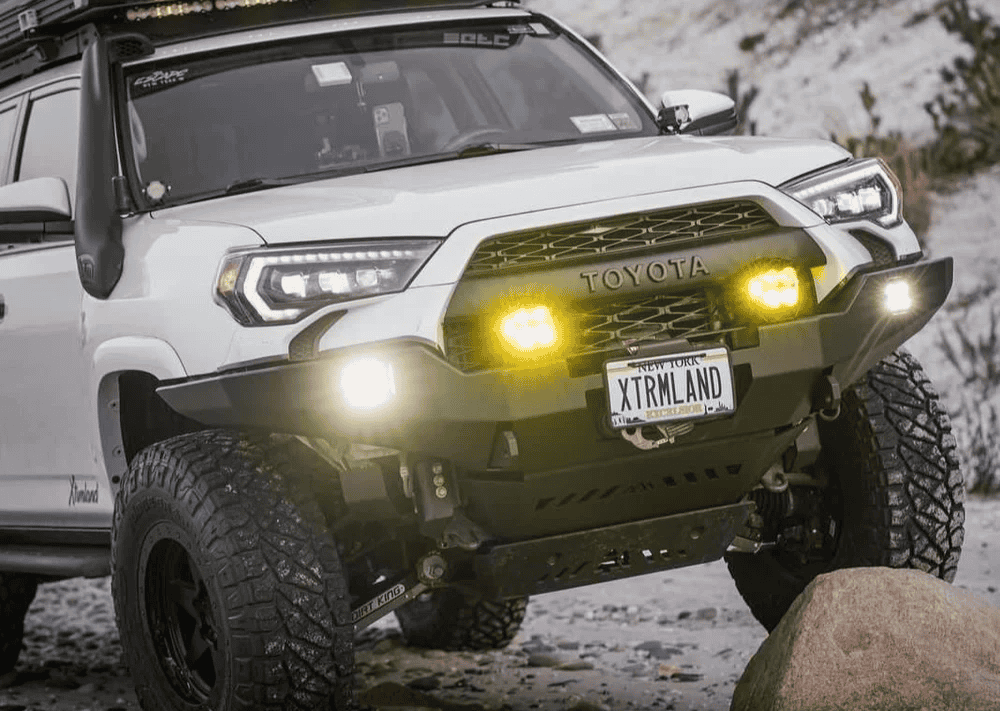Overland Vehicles

An expedition ready Tacoma TRD Pro rewards restraint. Start with weight, because every add on changes braking distance, suspension behavior, and range. Know the truck’s door jamb ratings, then weigh your rig at a scale with you, your travel partners, and a full tank. Build to a margin, not the limit, aiming to stay comfortably under gross weight and axle ratings. Balance front and rear loads so the truck sits level and tracks straight. The goal is a setup that feels predictable on broken pavement and steady in loose terrain.
Weigh the truck stock, then weigh after each phase of upgrades. Track front and rear axle numbers to keep steering precise and avoid rear sag. Heavy armor, swing gates, and roof loads add up quickly. Replace overlapping gear with multi use items and keep tools compact. Pack water low and centered. When in doubt, remove something before you add something new.
Tire choice changes the truck’s personality. A quality 33 inch tire works well for long mixed terrain travel, with reasonable mass and easier spares management. Thirty fives are possible with trimming and careful offset choices, but they slow acceleration and demand more brake and gear attention. Whatever size you choose, aim for a strong sidewall, reasonable weight, and a tread that clears mud yet runs quietly on long highway stretches.
Calculate real world consumption with your trip load, tire size, and terrain. Many Tacoma builds see a notable drop in economy once loaded. Decide if you need extra fuel based on your longest gap between reliable stations. Keep containers secured and outside the cabin. If your routes mix highway and washboard, consider how added weight and drag affect stability and braking.
Prioritize the systems you touch every day. Suspension should control weight without beating you up. Underbody protection should guard the vitals without turning the truck into an anchor. Electrical should be simple, labeled, and easy to diagnose. Storage should keep heavy gear low, and sleeping should let you rest without wrestling gear every night. If a component does not solve a defined problem, skip it.
Choose springs and dampers for your measured payload, not a guess. A small lift paired with matched spring rates can ride smoother than an over sprung package. Damping that controls small chatter reduces fatigue and keeps tires planted on corrugations. Keep geometry in mind with alignment that favors straight line stability under load. Re check torque and alignment after the first shakedown.
Decide between a second battery or a portable power station based on your loads and serviceability. Fridges, comms, lighting, and device charging are the usual draw. Use proper fusing, clean grounds, and tidy looms with abrasion protection. Charge from the alternator and consider solar as a supplement, not the backbone, unless you camp static for days. Label every circuit and keep a spare fuse kit.
High loads increase body roll and sap fuel economy. Keep storage modules as light as possible and bolt them securely. A low bed platform with drawers maintains a stable center of gravity and protects cargo. Roof tents are convenient but add wind drag and height. If you choose one, drive within the limits and watch crosswinds. A compact ground tent remains a solid option for longer highway approaches.
Protection should be targeted. Skid plates for the engine, transmission, and transfer case are high value. Rock sliders are cheap insurance when trails tighten. Avoid stacking steel on steel if you rarely scrape. Pack a full size spare, a well rated jack, a repair kit, and a compressor. Add soft shackles, a quality strap, and solid recovery points. Navigation and communications matter too, with offline maps and a way to call for help when out of service.
Armor only what you are likely to hit. Heavy bumpers can push you over weight and change approach and braking feel. If you run light trails, a simple front protection plate and sliders might be enough. Keep visibility and cooling in mind when adding front end parts.
Recovery is about planning, not heroics. Practice safe rigging and keep hands clear. Use a shovel first, air down when appropriate, and build ramps with boards or mats before pulling hard. Work slowly and communicate with your team. Store dirty gear in a vented bag outside the cabin.
Fresh fluids, healthy brakes, and well torqued hardware beat big add ons. Pack belts, hoses, tire plugs, and fluids you cannot buy in remote towns. Clean air filters and inspect suspension bushings after dusty trips. A tidy tool roll and a headlamp can turn a setback into a short pause.
If you want the truck wired clean, weight balanced, and field serviceable, professional help can save time and headaches. Explore our Overland rigs to see how a complete approach brings suspension, power, and storage together. For targeted work, our Custom overland upfit process plans every circuit and fastener around your route, payload, and crew. Curious about our build philosophy and client experience in Fayetteville Arkansas? Read Why choose OZK Customs.
Bring us your Tacoma TRD Pro goals and a packing list. We will measure, model, and deliver a setup that drives calm on pavement and stays composed on long dirt days. Tell us how and where you travel and we will turn that plan into a clean, reliable truck that is easy to live with and easy to maintain.
Ready to turn your Tacoma TRD Pro into a reliable expedition platform? Share your route goals and payload needs and we will design a clean, serviceable upfit that drives like stock on the road and tracks true off grid. Submit the form to start your build plan with OZK Customs.
ADDRESS:
6159 E Huntsville Rd, Fayetteville, AR 72701
PHONE:
(479) 326-9200
EMAIL:
info@ozkvans.com